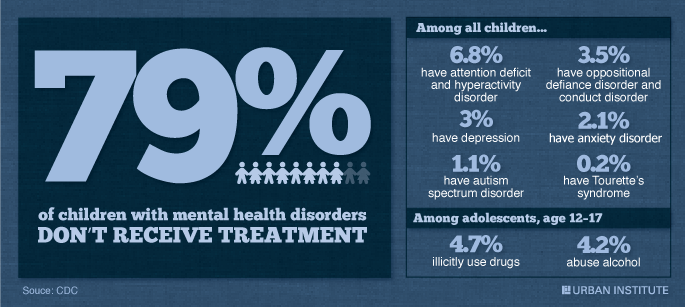

The White House on Monday will host a mental health summit in support of its campaign to stem gun violence. Given recent Center for Disease Control and Prevention (CDC) data showing that about 20 percent of American children suffer from mental illness, the attendees should look broadly for ways to help these kids.
The good news is the Affordable Care Act goes into effect next year, and with it comes new opportunity to both increase kids’ access to mental health treatment and to rethink how we pay for such services.
The bad news is the CDC’s study revealed a number of alarming trends regarding the ways children learn, behave, and cope with their emotions, including:
- Only 21 percent of children with mental health disorders receive treatment,
- About 6.8 percent of kids between the ages of three and 17 are affected by attention deficit and hyperactivity disorder,
- Around 4.7 percent of adolescents between 12 and 17 illicitly use drugs,
- Another 4.2 percent abuse alcohol,
- Roughly 3.5 percent of kids are diagnosed with oppositional defiance disorder and conduct disorder,
- About 3 percent of children are diagnosed with depression,
- Some 2.1 percent suffer from anxiety disorder,
- Around 1.1 percent of kids are diagnosed with autism spectrum disorder,
- Lastly, 0.2 percent are diagnosed with Tourette’s syndrome.
When most people think of American youth, they think of people living the healthiest days of their lives. But the reality revealed by the CDC’s study shows us that our kids need more help than they’re getting, not less.
Unfortunately it is only in the aftermath of such tragic events as the movie theater shootings in Aurora, Colo., or the attacks at Rep. Gabby Gifford’s public gathering in Casa Adobes, Ariz., that we collectively ask ourselves how some young person could reach such a terrible mental state.
So where do we go from here? The ACA is a big opportunity to restructure the services available to the growing number of children that need mental health care, but it will take some collaborative work from policymakers to get it done right.
My colleagues Michael Pergamit, Vicki Chen, and I studied the health status and costs of youth aging out of Medicaid in 10 states. We found that mental health problems account for a large portion of Medicaid costs for these youth as they approach adulthood. Less than a fifth of 18-year-olds enrolled in Medicaid account for the majority of the money Medicaid spends on kids of this age.
Indeed, 57 percent of the funds are spent on the 18 percent who receive Supplemental Security Income (SSI) (because they are disabled), are in foster care, or have a behavioral or developmental diagnosis.
But we saw that as kids age out of traditional Medicaid, many of them drop off the mental health and disability coverage radar, right at a critical junction in their lives.
Currently, almost half of the youth enrolled in Medicaid become uninsured after they age out of the program at age 19.
In the 30 states that offer an extension known as the “Chafee option,” foster youth are covered under Medicaid until age 21. SSI beneficiaries with a severe enough disability get coverage even after they turn 19, but in many cases they need to re-qualify. In both scenarios, enrollment procedures and state policies still interrupt coverage too often.
Of greater concern are the 10 percent of young adults who have behavioral and developmental problems but may lose their Medicaid coverage at age 19. They will need to re-enroll in states that take the Medicaid option under the ACA, and may lose coverage altogether in states that do not take the option.
The White House’s fiscal year 2014 budget request includes $205 million to identify mental health concerns early, improve access to mental health services, and support safer school environments. It also asks for $30 million to develop tools and conduct research on gun violence prevention, including key mental health issues.
As a part of that, initiatives would be launched in 8,000 schools to identify early signs of mental health problems and refer young people in need to services. The budget would also pay for more than 5,000 new mental health professionals to provide this help.
These investments would be very useful, especially given the needs revealed by the CDC’s study. But given the costs of mental health and disability treatment shown in our study, our government will probably have to devote even more resources to this critical area of care.
And as the program is implemented, state officials and Medicaid policymakers will need to work to ensure that the procedures required for enrollment aren’t overly complicated. It is critical that kids in need of mental health treatment and disability coverage don’t slip through the cracks.
Tune in and subscribe today.
The Urban Institute podcast, Evidence in Action, inspires changemakers to lead with evidence and act with equity. Cohosted by Urban President Sarah Rosen Wartell and Executive Vice President Kimberlyn Leary, every episode features in-depth discussions with experts and leaders on topics ranging from how to advance equity, to designing innovative solutions that achieve community impact, to what it means to practice evidence-based leadership.